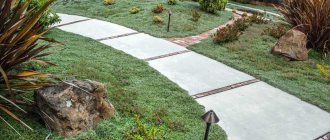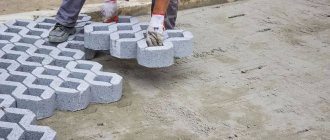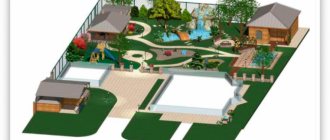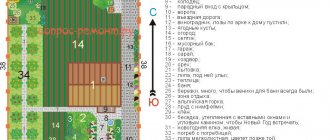People rarely devote much time to arranging garden paths. Meanwhile, it is very important to take everything into account at the beginning, that is, when planning. This includes the material from which they will be formed, the shape of the lines, the convenience of location, and much more.
Such an omission may cost you money, because in order to move an incorrectly placed track even by 20 centimeters, it will have to be completely dismantled and made again. To prevent this from happening, you need to calculate everything in advance and pay attention to the recommendations of specialists.
A few general recommendations for constructing garden paths
So, remember the following recommendations:
- Within one summer cottage, no more than two or three types of coating are most often used. Using more paving materials is considered to be in poor taste.
- It is considered optimal if the paving area is 5-20% of the size of the plot. If you pave a larger area, it will not look aesthetically pleasing (especially if the garden is decorated in a natural style).
- When choosing a coating, it is important that it is combined with the material of the buildings and does not stand out from the general appearance.
Where to begin
If you decide to arrange paths in the garden yourself and at low cost, then you need to understand in advance such aspects that will directly affect the organization, the total cost of the work and the progress of its implementation:
- planning and marking;
- selection of material for paving the path on the site;
- choice of base and installation technology;
- determining the need for additional procedures to extend the life of the finished coating.
These points are interconnected from a technological point of view. For example, if natural stone is chosen for paving, then additional protection will not be needed. And in the case of a concrete base, the coating will be stable and will provide the opportunity to use softer and thinner slabs.
All four points are largely technologically interconnected. For example, the use of durable natural stone eliminates the need for a number of works to provide additional protection, and the installation of a concrete base increases the stability of the coating and makes it possible to lay softer and thinner slabs.
How to arrange paths on the site
In order to correctly place paths on the territory, they must be identified in advance on the plan. Try to take into account all the buildings that are on your summer cottage. It is better to lay the path leading to the main entrance along the longest route, giving the landscape component a “soft” wave shape.
The norm for the route from the back door of the cottage to the barn is a straight path. This will help maintain the functionality of the household. blocks. Don’t forget, garden paths help not only to decorate the local area, but also to properly organize the free space.
Excavation of excess soil
After clearing the area of the path and laying out its coordinates on the ground, we begin to remove the soil. The first question: how deep to dig? The distance between the plane of the path (stretched string) and the lower level of the removed soil consists of: a bearing layer (crushed stone) - about 15 cm, a leveling layer (sand) - 3-5 cm, and the tile itself.
For information: in this case (with a tile thickness of 7 cm) this distance is 25 - 27 cm. Do not forget that the top mark is a string, and from it we measure 25 cm in depth.
When removing soil, use both bayonet and shovel shovels. Part of the removed soil will later be used for sprinkling curb stones on the outside, part for land leveling, and part is to be removed from the site.
After excavating the soil to the required depth, it would be a good idea to walk over the entire surface of the path bed with a tamper (the most affordable option is a wide log with a cross-shaped handle).
What to consider when planning a path
When planning a path, try to do everything sequentially:
- First of all, make a plan in which you highlight the beginning and end of the route. Lay household items. paths of optimal length. Try to avoid sharp turns and do not make the paths very winding.
- Limit the number of garden paths.
- Calculate the correct length and width of the path on the site.
- Do not forget about the overall style; the path should be designed accordingly and not be conspicuous.
- Use materials that are designed specifically for garden paths.
Optimal size
After you decide on the location of the path on the territory, take care of the dimensions. Almost the entire path should have the same width. It should be increased only at the approaches to commercial and residential buildings.
Attention! If you want two people to be able to move freely along the path, then the width of the path on your summer cottage should be within 80 centimeters.
After planning the route, determine the optimal width of the garden path, taking into account the following architectural features:
- make a main path between the gate and the cottage, about 1.5 meters wide. This is necessary so that two people can walk along it;
- make secondary paths (to the bathhouse, gazebo, barn, etc.) narrower.
- approximately the width of the garden path should be 90 centimeters.
Which paving stones to choose?
When choosing paving stones, it is better to avoid buying too bright models, since a large amount of dye can have a bad effect on the quality of the product. Over time, they may become stained. Bars of muted shades will be of higher quality. If you need to check the uniformity of coloring of the product, you can break the tile into several parts and evaluate its chipping. If there are clumps of clay, sand or dye, it is better to refuse to purchase such tiles, as this indicates a poor quality of the product.
Porch paved with paving stones Source skladklinkera.ru
Options for garden paths
Tracks are divided by type of material, i.e. what they are made of. They are also distinguished by size and purpose.
By material
A dacha or garden plot can be decorated with paths, made from a variety of materials. Typically, one of the following nine is used to create paths:
- a natural stone;
- tree;
- special road type covering;
- brick;
- concrete solution;
- gravel;
- plastic;
- lawn;
- Tennis.
Of course, this is not a complete list of building materials suitable for creating paths; you can use something else.
By size and purpose
All transitions are divided into two groups: utilitarian and decorative. The first group includes functional and economic type paths. Their width depends on why they are being built. For utility paths, the width is from 60 to 120 centimeters.
But the size of the path in the country depends on the size of the car and varies in width from 2.5 to 3 meters. If you think about decorative paths - they are created only for walking, they are used less often than utilitarian ones, their sizes usually start from 60 cm and reach up to 1.5 m. According to their purpose, the above paths are divided into:
- main ones - considered the main connecting component, have a width of 1.2 m, which is enough for two people, and are located in the center of the site;
- secondary and connecting - they depart from the main paths in different directions, have the simplest configuration so as not to create competition with the main crossings, these include garden and garden options.
Logic of convolutions
The main path is usually laid along the shortest line. All other garden paths do not have to be straight; on the contrary, they will only benefit from a smooth bend that is pleasing to the eye. But at the same time, it is important that all bends are thought out and logically justified. Why, for example, did the path go on and on, and then suddenly turn somewhere? On her way, she encountered an “obstacle” (a flower garden, a decorative stone, a tree, a sculpture) and “decided” to smoothly get around it. This unobtrusive naturalness of the curves gives a picturesque charm to the design of the path. Properly planned and arranged, they will harmoniously fit into the appearance of the site and give it a finished look.
Do not try to amaze your neighbors with the construction of “large-scale palace” walking alleys, do not get carried away by the countless number of paths: this will visually split the territory, and the garden as a single form will be lost. In addition, the paths “eat up” useful space, which can be occupied by decorative or fruit plantings
Materials for covering garden paths
The material is selected using two main criteria. The most important is the power of influence. Whether a girl with a stroller will walk along the path or vehicles will drive - all this will require different strength. Naturally, you can protect yourself and make all tracks with a maximum calculation. impact forces. But it is necessary to realize that the cost directly depends on this factor. It's up to you to decide whether it's worth spending a lot of money to make a durable path to your outdoor shower, barbecue or garage.
Types of coating can be divided into two types - hard and soft. Most often, hard ones are used where the force of impact on them is significant. Soft - on additional, seasonal and little-frequented paths. This reduces their cost several times. Hard ones include:
- concrete solution;
- paving slabs;
- a natural stone;
- asphalt.
The soft ones include:
- gravel, marble or crushed stone fill;
- wood chips and bark;
- tree cuts;
- lawn.
The second important point is the unity of style. There are universal building materials. They are used regardless of style, these are concrete mortar, paving slabs, crushed stone and lawn paths. But there are also those that will look strange if used incorrectly.
Marble, polished granite and paving slabs with different images and unnatural color schemes are not suitable for a natural style. But for this style direction you can use natural stone, without processing, wood, bark. For the regular style, the opposite is true.
Stitches for the horned violet
Where there is little traffic along the path, we will plant low creeping, creeping, cushion-shaped “alpine” plants in the gaps between the tiles. In the shade between the tiles, bryozoan and bryophyte saxifrage grow well. Under the canopy of trees in moist soil in the seams, small-flowered daisies and horned violets bloom well all summer. Unpretentious sedums, young plants, low cushion-shaped carnations, armeria and fragrant thyme are readily preferred by seams in the sun. But then you can’t do without regular weeding and monitoring the growing turf.
Rules for caring for paths on a personal plot
As mentioned earlier, the garden path needs maintenance. You need to monitor the condition of the track material, the shape, and the details of its design. Caring for many building materials is similar, but in each individual case there are certain nuances:
- The process of caring for concrete paths is simple, they need to be kept clean, then they will last longer and will not lose their beauty. They clean up such a path using a broom, a vacuum cleaner or a regular watering hose. It is necessary to periodically monitor the growing plants between the slabs and get rid of them in a timely manner. Weeds are pulled out with your own hands or treated with herbicide. Oil stains from the surface are removed using a garden solution. Cracks often appear on concrete. If the crack grows, it is rubbed with special means. When there are too many of them, the entire destroyed section of the trail is replaced. The holes are repaired in much the same way - the edges are chipped off, the entire internal surface of the hole is covered with PVA glue, and then rubbed with a solution.
- Caring for paths made of natural stone can be considered simple, because this material is undemanding and durable. Even in winter, they can be cleaned in any way. Slabs for paths are most often made from a single piece, and the stone is considered to be inherently resistant to temperature changes and high humidity. But even if chips appear on this building material, this will not affect its external characteristics in any way. You just need to remove grass and debris from the path. The exception is slate or limestone slabs, which must be coated with water-repellent agents.
- Caring for paths made of pebbles, gravel or crushed stone is also not difficult. Paths made of such materials must be protected from excess moisture. A water drainage system will protect the trail from streams. Weeds should be removed immediately, but moss can be left for beauty. If a hole appears on a path made of bulk building materials, the entire top layer is removed, and then stones are poured and compacted.
- Maintaining a brick path . If the path is made of a material specially created for this purpose, then it does not need to be maintained. If a simple uncoated brick was used for construction, then such a path will not last long, no matter what you do. You can extend the service life if you install a drainage system and remove debris with a broom.
- Caring for a wooden walkway is more difficult. The coating must be periodically cleaned using a metal scraper, treated with an antiseptic and reapplied. Types of protective coating for wood - drying oil or coloring agent. Ideally, it is best to treat the entire driveway once a year. It is also better to monitor the condition of the material itself so that no defects appear on it.
- Caring for a plastic walkway is easy. You can wash it with a hose; this should be done several times a month. In winter, this path is cleaned carefully to avoid scratches. If some parts have failed or begun to loosen, then they are removed, a little of the base on which the track was placed is added, and the components are put in place.
- take care of the ceramic tile path delicately. Such paths are quite fragile and difficult to interact with in winter, because it is necessary to remove snow. In summer, you need to completely remove dirt from the tiles with a mop or sweep away debris with a soft broom. You will also need to monitor the condition of the tile joints. They will sometimes need to be sealed with a strengthening agent or cleaned and refilled.
- how to care for a walkway made of decorative concrete . Once a year, the concrete surface is treated with a water-repellent mixture, and if the concrete is painted, then a transparent coating is used to restore its richness. When clearing snow from a concrete path, you need to act carefully so as not to damage anything.
- Caring for grass paths is considered the most labor-intensive. A walking lawn like this needs to be watered several times a month. The grass on the path must be mowed periodically. The cut grass is not removed immediately, but is left for several days so that the soil layer on the path does not dry out. In autumn, watering and mowing are stopped due to lower temperatures. In order for the grass path to look amazing for a long time and the cover to remain thick, it needs to be loosened. This manipulation can be performed by punctures or cuts in the soil layer before watering. In the spring, such a path must be fertilized.
Setting a Budget
The amount of financial investments can be affected by: the base for the path, the paving area, the chosen model of paving stones and its price. The most budget option would be to use simple tiles of one type. The choice of natural stone tiles will be expensive.
To reduce the burden on the family budget and at the same time get a high-quality result, it is recommended to divide all work into several stages.
Technology for laying paving stones Source buildhouse.rf
What to pave with?
It is very stylish if the material of the house itself is partially used in paving paths around the house. If you have a brick house, it will be great if the path or area near the house combines, for example, brick with concrete tiles or brick borders with natural stone paving. But only clinker bricks can be used; ordinary building bricks will crumble in a couple of years.
The base of the house, lined with stone, suggests the use of stone in covering the adjacent paths. Running from the building into the garden, from one zone to another, the garden path can be transformed: paving stones are replaced by flagstone, and this, in turn, is replaced by a gravel embankment. A soft flow of coatings can be achieved by combining them at transition points, as well as by repeating elements of the previous coating in the next.
It would be wrong to think that a plot with a wooden house should be paved only with wood. Wood materials combine well with natural stone, gravel, concrete or porcelain tiles. If you have a luxurious stone house in the English style, and you would like to design your garden in the same style, make gravel paths. It will be very English!
Installation of curb stones and completion of the load-bearing layer
Now you can begin installing the curb stone - garden border. To do this, remove the previously installed pegs with strings and reinstall them closer to each other in width. Now the width between them is the width of the row of tiles laid on the tracks plus the installation gap - about 0.5 cm (in this case, 60.5 cm for the main part of the track and 80.5 for the additional one).
Strings stretched and aligned in planes are a guideline for installing a border for garden paths. The inner top edge of the curb stone is almost identical to the twine.
Add a little sand under the base of the curb if you need to raise the curb by a distance of up to 1 cm. Level the sand, pour it and compact it.
Use a heavy hammer or sledgehammer to compact the crushed stone if necessary, lowering the curb up to 1cm.
To install and secure curb stones, use concrete (crushed stone, sand, cement, water).
When placing a curb stone, use a building level to ensure its correct position. All curb stones must be in the same plane with adjacent curbs on the same branch, with adjacent curbs on a parallel branch, and stand clearly at an angle of 90 degrees to the surface of the ground.
After installing the curb stone, it is necessary to complete the installation of the load-bearing layer of the path foundation. To do this, you need to raise the height of the load-bearing layer by another 10 cm. Therefore, we add crushed stone, while tamping it layer by layer.
After compacting is completed, it is recommended to sprinkle the crushed stone with sand and water it thoroughly with a hose. The sand will settle, fill the voids in the crushed stone and make it monolithic.
Cobblestone and gravel
The path paved with cobblestones looks good. The foundation for it is a layer of gravel with a layer of sand and clay poured on top of it. Laid out randomly or in a pattern, the cobblestones will become a spectacular decoration of the landscape. The combination of wooden flooring and cobblestones will enhance the Japaneseness of the Japanese garden you create.
Gravel paths are universal in use; they can be installed both at the entrance to the house and in the most remote parts of the site. They are beautiful in their naturalness, inexpensive, and easy to make into any shape. They are made slightly deeper than the soil surface. A deep trench is dug under the gravel path and its bottom is compacted well. To prevent the germination of weeds and the “leakage” of gravel into the ground, geotextiles are laid at the bottom. Gravel paths require curbs, otherwise the loose coating will “scatter” into flower beds and lawns. The gravel is poured in thin layers with each layer compacted tightly.
As you move away from the house, for example in the walking part of the garden, use completely different materials. This will emphasize that this is a different zone. Combining paving materials is a very interesting technique; if used skillfully, it will emphasize the style of each zone and at the same time combine the composition of the garden into one whole. Just don’t use more than three paving materials at the same time.
Construction of the first part of the load-bearing layer - leveling
The next stage in the construction of a garden or country path is the construction of a load-bearing layer - the main part of the foundation.
First of all, we lay a leveling layer of crushed stone 5-7 cm thick, which is essentially part of the load-bearing layer of the foundation. It is on this that we will install the curb stone.
Having evenly distributed the crushed stone over the entire surface of the bed of the infield path, we must compact it. We control the level of crushed stone by measuring the distance from it to the string. It should be equal to the height of the curb stone.
At the end of compaction, sprinkle the leveling layer with sand and water. It is advisable to do this, since sand penetrates inside between the crushed stone and makes the crushed stone layer monolithic.
We use lawn grates
Nowadays, paths and playgrounds are often made using lawn gratings and honeycomb panels made of high-density polyethylene. The lattice installed on the prepared base is covered with fertile soil and sown with grass. The result is a lawn with high mechanical strength (withstands loads of up to 200 t/sq. m), which can serve as a parking lot, driveway or pedestrian path.
The important thing is that, unlike a regular lawn, you can walk on it in early spring and in any weather.
Lawn grates are modular designs, they are equipped with a reliable connection with latches and are easy to install. The necessary bends of the tracks are made using cutting tools. The thickness of the base for the gratings is determined by the nature of the load on the surface. For example, the sand and gravel pad at the entrance to the garage should be 30 cm thick at the parking lot.
With the help of lattice cells, you can not only grow a lawn that is resistant to mechanical stress, on which you can walk at any time of the year in any weather. If you fill the cells with fine gravel, you will get a gravel pad, driveway or parking lot.
If there is a forest area in the garden, then it will look logical and natural not to have paved paths, but to have wooden flooring, as well as paths made of gravel or wood chips.











